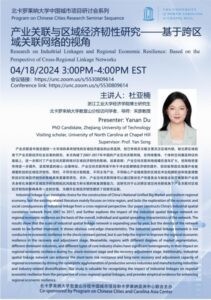 Hosted by the Program on Chinese Cities (PCC)
Hosted by the Program on Chinese Cities (PCC)
04/18/2024 3:00 PM-4:00 PM EST
Presenter: Yanan Du
PhD Candidate, Zhejiang University of Technology
Visiting scholar, University of North Carolina at Chapel Hill
Supervisor: Prof. Yan Song
Abstract:
Industrial linkage is an inevitable choice for the construction of China’s National Unified Big Market and resilient regional economy, but the existing related literature mainly focuses on intra-region and lacks the exploration of the economic and social consequences of industrial linkage from a cross-regional perspective. Our paper constructs China’s industrial spatial correlation network from 2007 to 2017 and further explores the impact of the industrial spatial linkage network on regional economic resilience on the basis of the overall, individual, and spatial spreading characteristics of the network. The results show that the scale of the industrial spatial linkage network is expanding year by year, but the density of the network needs to be further improved. It shows obvious core-edge characteristics. The industrial spatial linkage network is not conducive to economic resilience in the shock-resistant period, but it can help the region to improve regional economic resilience in the recovery and adjustment stage. Meanwhile, regions with different degrees of market segmentation, different dominant industries, and different types of core industry chains have significant heterogeneity in their impact on regional economic resilience during the shock-resistant stage and the recovery-adjustment stage. Additionally, an industrial spatial linkage network can enhance the short-term risk resistance and long-term recovery and adjustment capacity of regional economies by driving the synergistic agglomeration of productive service industries and manufacturing industries and industry-related diversification. Our study is valuable for recognizing the impact of industrial linkages on regional economic resilience from the perspective of cross-regional spatial linkages and provides empirical evidence for enhancing regional economic resilience.
